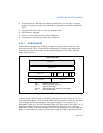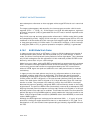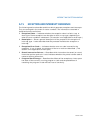
6-20 Vol. 3
INTERRUPT AND EXCEPTION HANDLING
of the EFLAGS register on the stack. Accessing a handler procedure through a trap
gate does not affect the IF flag.
6.12.2 Interrupt Tasks
When an exception or interrupt handler is accessed through a task gate in the IDT, a
task switch results. Handling an exception or interrupt with a separate task offers
several advantages:
• The entire context of the interrupted program or task is saved automatically.
• A new TSS permits the handler to use a new privilege level 0 stack when handling
the exception or interrupt. If an exception or interrupt occurs when the current
privilege level 0 stack is corrupted, accessing the handler through a task gate can
prevent a system crash by providing the handler with a new privilege level 0
stack.
• The handler can be further isolated from other tasks by giving it a separate
address space. This is done by giving it a separate LDT.
The disadvantage of handling an interrupt with a separate task is that the amount of
machine state that must be saved on a task switch makes it slower than using an
interrupt gate, resulting in increased interrupt latency.
A task gate in the IDT references a TSS descriptor in the GDT (see Figure 6-5). A
switch to the handler task is handled in the same manner as an ordinary task switch
(see Section 7.3, “Task Switching”). The link back to the interrupted task is stored in
the previous task link field of the handler task’s TSS. If an exception caused an error
code to be generated, this error code is copied to the stack of the new task.
When exception- or interrupt-handler tasks are used in an operating system, there
are actually two mechanisms that can be used to dispatch tasks: the software sched-
uler (part of the operating system) and the hardware scheduler (part of the
processor's interrupt mechanism). The software scheduler needs to accommodate
interrupt tasks that may be dispatched when interrupts are enabled.
NOTE
Because IA-32 architecture tasks are not re-entrant, an interrupt-
handler task must disable interrupts between the time it completes
handling the interrupt and the time it executes the IRET instruction.
This action prevents another interrupt from occurring while the
interrupt task’s TSS is still marked busy, which would cause a
general-protection (#GP) exception.


















